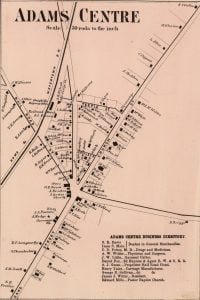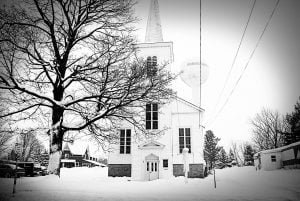
This pleasant village, of 500 inhabitants, is situated on the upper lake ridge, which here forms a plain, three miles north of Adams, and ten miles by railroad from Watertown. The location is very favorable, and, being surrounded by a rich farming country, the place has become noted for its many comfortable homes, substantial business men, and beautiful streets. Settlement in this’ locality was first made in 1816, by Luman and Hiram Arms, who opened a farm just north of the village site. The place was densely timbered with cedar and the hard woods of this section, and clearings were made with great difficulty. The first house where the village stands was built by a man named Priest, who sold out to Luman Arms before it was entirely completed. South of the village lived R. Warriner, who kept a tavern in a frame house as early as 1810 and continued it until about 1827. It was the first public-house in this locality, and was a great place of resort. Other settlers came to the Five Corners (now Adams Centre) in 1818, and in 1822 Hiram Arms built a wagon-shop, where the trade was carried on by him and his brother for more than forty years. Julius Palmer built another shop in 1850; and soon after Pliny Wright put up a building for a like purpose. Both places are now occupied as wagon-shops. A blacksmith, named Wellman, came in 1823, and others of the craft soon followed, and opened shops, several of which yet remain.
In 1827, Luman Arms built a substantial two-story house, which he opened as “Arms’ Inn.” Additions were made from time to time, and the house has ever been used for hotel purposes, being now known as the Talcott House. The house known as Merchants’ Hotel was used as a private residence until 1867, when Dr. Wilder had it changed to an inn. After the completion of the railroad, a hotel was built near the depot by E. Oatman, which is generally used for this purpose.
Jonathan Davis built the first store, about 1830. His business increased so much that he erected a fine business block, where he remained a successful merchant many years. Upon retiring from trade he was succeeded by O. Davis and W. D. Arms. Calvin Green built a store in 1835, and Joseph Dewey another a little later, where Joseph Davis was in trade a number of years.
Union Block, the only brick structure in the place, was erected in 1860, by Hull & Whitford, general merchants at that time. The upper story forms a fine hall, which is used for town-meetings and public gatherings.
The first physician to locate permanently in the village was John T. Dickinson, who remained in practice many years. Several years after his settlement, A. P. Hale, an eclectic, located there; in 1846, E. R. Maxson began practice; in 1855, William O. Bailey, who still continues; about the same time C. D. Potter; and, later. Dr. Wilder. Besides Dr. Bailey, Dr. C. F. Wright is at present also in practice.
The manufacturing interests of the place are limited to the “Adams Centre Sash-and-Blind-Factory,” O. De Grasse Greene, proprietor, and established by him in 1868. It is operated by water-power from a spring-pond, a view of which appears in this work. Mr. Greene is also a builder, and carries on his business on a large scale in several well-arranged buildings.
The “Handy Package Dye-Factory” was erected by Dr. C. D. Potter, in 1874, the manufacture of the dyes having commenced in 1870. A new building, 20 by 40 feet, two stories high, was erected in 1877, to accommodate the growth of the business. The factory is supplied with an engine, printing-presses, and employs ten hands. The goods are in great demand, and orders are received from all parts of the Union.
A resume of the business of Adams Center shows: architect, 0. De Grasse Greene; attorney, A. E. Corley; physicians, William C. Bailey, J. P. Wright; general merchants, Jacob Tittsworth, J. C. Heath, E. C. Crosby; druggist, M. D.. Tittsworth; furniture and undertaker, R. C. Langworthy; millinery, Mrs. J. E. B. Curry, Mrs. J. C. Heath, and Mrs. Jacob Tittsworth; grocer, George Horth; hotels, Talcott House, F. A. Talcott; Railroad House, B. K. Dewey; flour and feed store, Alvah Green; and express and station agent, Daniel Fox. There are also 3 wagon-shops, 3 blacksmith-shops, 2 cooper-shops, 1 tailor, 1 harness-maker, 2 shoemakers, and a few other shops.
The post-office at Adams Center was established at an early day, Danford Doty being one of the earliest post-masters. Since then the office has been held by C. Hubbard, D. Fox, C. D. Potter, and M. D. Tittsworth, the present incumbent. It was made a money-order office August 1, 1871, and the orders given and received amounted to $10,000 per annum; registered letters, 80; letters received daily, 225; sent, 320; newspapers per week, 1500.
The Adams Centre Cornet Band was organized in 1871, with fifteen members; J. C. Heath being the first leader. At present there are fourteen members, and George L. Fox is the leader. In September, 1876, the band competed for a silver service at the Jefferson County fair, receiving the prize. The instruments used are full nickel-plated, and the music executed consists of selections from classical writers.
The “Union Cemetery Association” of Adams Center was formed April 1, 1867, and nine trustees chosen, as follows: Luman Arms, Joel Dewey, Leonard R. Green, Abram Sheldon, A. J. Green, Eh A. Seely, Charles Potter, Peter W. Dyer, and Hiram Segur. Charles Potter was elected president, and E. A. Seely superintendent, which office he has held ever since. The association secured the old burial-ground, south of the village, which was set aside about 1808, and which contains the graves of a number of soldiers of 1812, and enlarged it to about four acres. The ground was surveyed into 344 lots, with appropriate walks and drives. John Cooley was the first interred in the new ground, April 30, 1867. The number of burials since that date has been 225; number in the old ground, 240. The cemetery is well situated, is enclosed with a neat fence, and presents a very fine appearance. The present officers are: Silas Chamberlain, A. J. Green, Henry Yates, E. A. Seely, Charles Potter, R. Q. Green, R. C. Langworthy, Hiram Segur, Leonard R. Green, trustees; R. C. Langworthy, president; and C. D. Potter, secretary.
The Adams Center Union Graded School
The first school-house in the village was a small plank building, near the forks of the road, erected in 1823, by L. and H. Arms, R. Warriner, and Major Earl. This was used until 1829, when a stone house was built, in which schools were taught until the present structure was erected in 1857. This is a two-story frame, with three rooms, and was occupied as a district school-house until 1876, when the school was graded, a board of education elected, and the house came under their control. The first board was composed of C. D. Potter, J. A. D. Snell, J. J. Witter, E. C. Crosby, T. Williams, W. Fuller, A. J. Green, Asa M. Green, J. Q. Arms. J. Q. Arms was elected president, C. D. Potter clerk, and J. C. Heath treasurer and collector. Rules and regulations for the government of the board and the school were adopted, and W. C. Porter employed as principal and teacher in the senior department. There are, besides, two assistants in charge of the primary and junior departments. The attendance is 120 pupils, and the school bears an excellent reputation.
Adams Center Baptist Church

About fifty members having withdrawn from the old Adams church, for the purpose of forming themselves into a church at the Center, on Dec. 17, 1852, they were organized with the above name. Abram Sheldon, J. W. Horton, and L. Allen were elected deacons. Meetings were held in the school-house until the completion of their church. In March, 1853, the “Adams Centre Baptist Society” ‘was formed, with 32 members, and Oliver McKee, Ezra Hull, and Silas Glasier, trustees. The following summer a fine frame church, 44 by 60 feet, with a tower in front, was erected on the principal street of the village, at a cost of $6000. It was dedicated Jan. 12, 1854, by the Rev. Butterfield, of Oswego. In 1877 the house was thoroughly renovated, and, with the parsonage, presented to the society by Deacon Abram Sheldon, is estimated worth $10,000. The present trustees are Silas Chamberlain, Eli Seeley, and John Snell.
Since the formation of the church. Revs. Teeple, Blunt, Wardner, Mills, Garfield, Hammon, Sawyer, Maine, and Williams have been pastors. During Revs. Blunt and Sawyer’s connection there were notable revivals, which augmented the membership of the church. At present it numbers 176. A Sunday-school was organized in 1854 by Rev. Teeple, which at present numbers 118 members. D. C. Maine is the superintendent.
Source: Durant, Samuel W. and Henry B. Peirce. History of Jefferson County, New York, With Illustrations and Biographical Sketches of Some of its Prominent Men and Pioneers. Philadelphia: L.H. Everts & Co., 1878. p 249-250.
